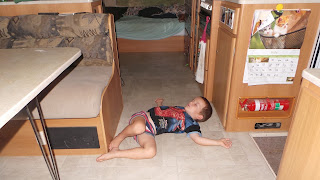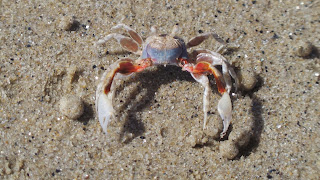This morning I wasn't quite quick enough to sneak out on my run before the family woke up, so with Fletcher on my back and Jarrah on his bike, I walked the 5km rainforest track along Cape Kimberley Road. We didn't manage to catch site of the elusive and critically endangered Cassowary (there are barely 1200 left in the Wet Tropics) but it was still a marvellous way to start the day!
After brekky, a bit of
Donkey and
Skip Bo we threw a picnic together and headed out to do some exploring. We stopped in at Mt Alexandra lookout where on a clear day you get a great view of Snapper Island, the mouth of the Daintree and the distant Port Douglas. Today was misty but it was beautiful all the same.
From here it was off to the Discovery Centre and then on to the Jindalba Boardwalk. After a picnic lunch, we donned our wet weather gear and spent some time wandering through the magnificent Daintree rainforest.
The Daintree rainforest has the most complete record in the world of the evoluation of plant life dating back to the beginning of life on earth, some 3.5 billion years ago.
We saw some great examples of Australia's largest fern, the king fern, with fronds as long as 5 metres. Australia's largest frog, the white-lipped tree frog, is also found here. Sadly, not a sign of him today. Perhaps that could have had something to do with the high pitched squeals of laughter as three young Johnstons delighted in shaking the palm trees in order to spill the accumulated raindrops on any unsuspecting traveller on the boardwalk?
Our next stop was Cow Bay. As we'd driven right past the icecream factory, the kids weren't too excited to get out for a walk here, until they came across these great coconut palm swings on the beach.
The Aboriginal name for Cow Bay Beach is Kaba-Kada, which means rain a lot. We weren't disappointed today! Apparently the sun only shines one hundred days a year here. The rain did nothing to weaken the boys' resolve to eat ice cream, however, so on the way home we stopped at Floravilla Ice Cream Factory - supernatural, biodynamic, organic and super expensive.
The ice cream was better than the coffee (which was out of a machine) and the flowers were pretty too!
As we headed for home we realised we'd been out for five hours and had travelled no further than 35 kms! A far cry from our recent travelling days in the Northern Territory! We arrived home in the late afternoon to find we'd been coned!
In the evening all weary travellers at the Koala Daintree Resort gathered for an impromptu pool competition and muso jam/sing-a-long. One fellow even brought along his pet funnel web! Arghh!
It was great fun but late by the time we finished up. Now you'd think the boys would be exhausted, but no, on the way back to our campsite there was great excitement when we came across a large cane toad.
One hundred cane toads were brought to Australia from Hawaii in 1935 in an effort to combat the cane beetle. I'm not sure who did the research on this one, but the cane beetle lives in the top of the cane, and cane toads can't jump very high. Hence they didn't eat the cane beetles. They did, however, have a marked effect on Australian biodiversity. And as the females can lay up to 25000 eggs at a time, it was recently estimated that the cane toad population in Australia is now around ten billion!
Thus, with a thought for all the native lizards, frogs, birds, crocs and snakes (not to mention plenty of domestic dogs and cats) who have died at the hands of the cane toad, the boys commenced a game of cane toad BMX. After about 10 minutes of this caper, the amphibious, flat, freak puffed himself back up and started to hop off! No way, we weren't standing for this. So Bruce stabbed him with a tent peg.
Good one honey!





















































